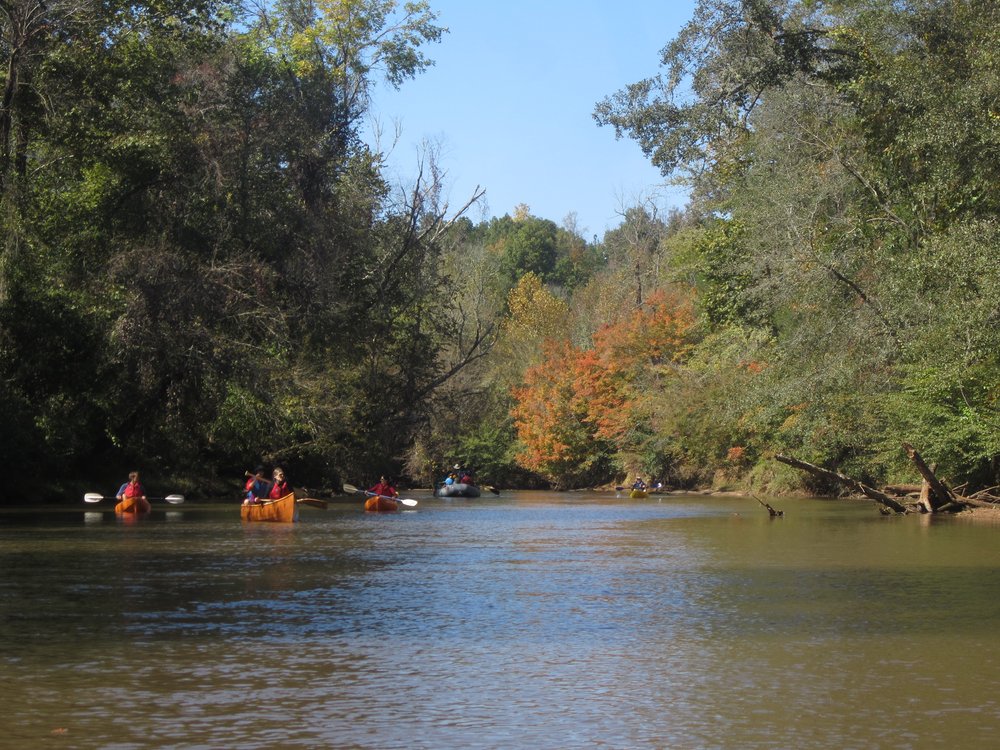New Year's Mountains
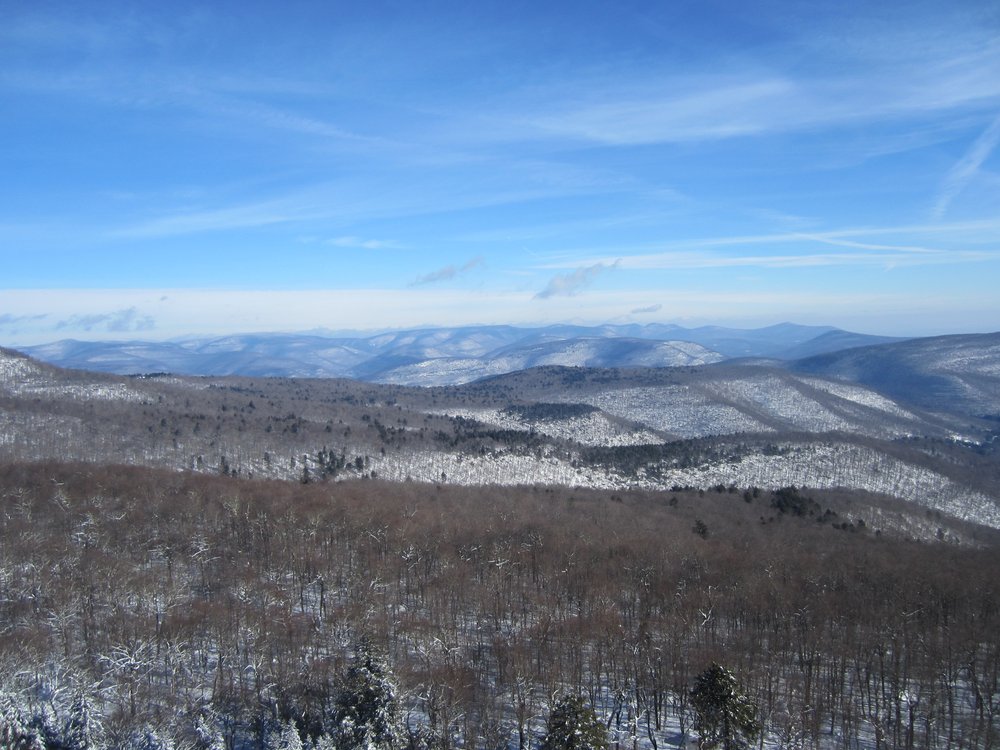
It was January 1, and we were five, ringing in the New Year by heading for the summit of Wittenberg. Wittenberg is 3,780 feet and is neighbors to Cornell and Slide in the Burroughs Range of the Catskills. The guidebook describes the climb up Wittenberg as “extremely difficult.” I had been up the mountain before, but on a spring day. And, I was feeling fresh that day. On this New Year’s hike I started out with sore legs; the day before, I had hiked up Giant Ledge and Panther with my friend Max.

It was January 1, and we were five, ringing in the New Year by heading for the summit of Wittenberg. Wittenberg is 3,780 feet and is neighbors to Cornell and Slide in the Burroughs Range of the Catskills. The guidebook describes the climb up Wittenberg as “extremely difficult.” I had been up the mountain before, but on a spring day. And, I was feeling fresh that day. On this New Year’s hike I started out with sore legs; the day before, I had hiked up Giant Ledge and Panther with my friend Max.
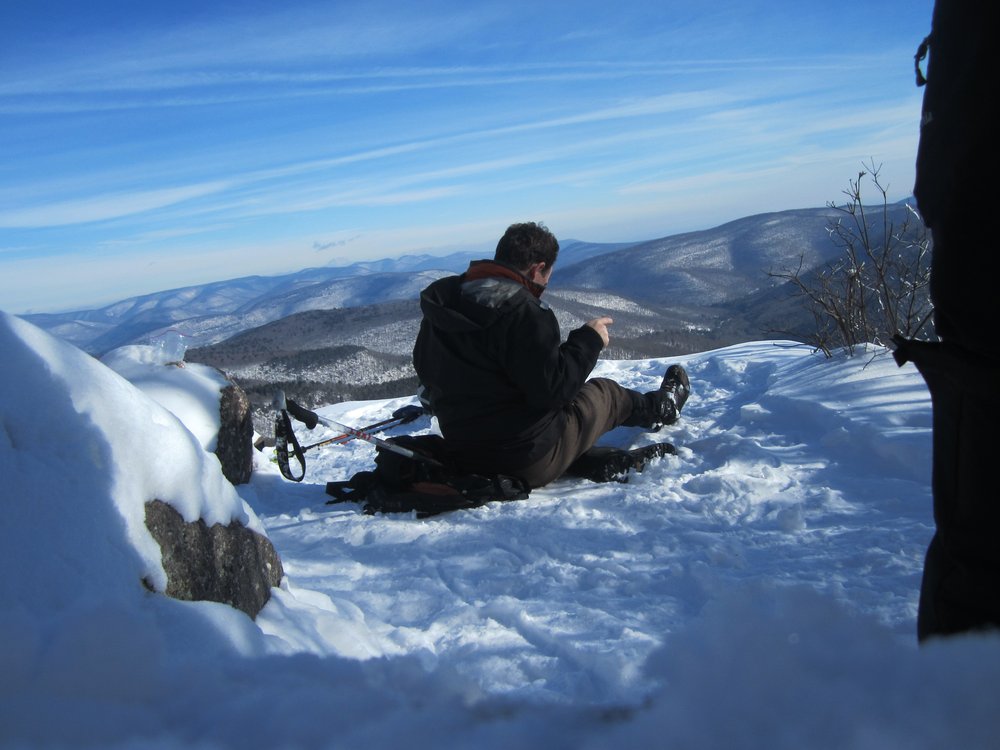
This was Max’s first Catskill hike and I wanted to take him up something with great views (not the case with every Catskill peak). We were not disappointed. The scan east toward the Hudson, to Overlook, Roundtop and Plateau was magnificent. After easily summiting Giant Ledge, we headed on to Panther, and returned to the car by three in the afternoon happy. On our walk I had seen exactly two birds: two Hairy Woodpeckers and a few Chickadees out in the sunshine. It was the perfect close to a not so perfect year.
I try not to place too much pressure on the New Year, but like many I have hopes that something might change. I don’t hope for anything too farfetched like world peace or finding love or not ever hearing the words fiscal cliff again. I keep it small: that I’ll write with more focus or become a better birder. When you spend a day hiking up a mountain, you are not writing. And a mountain in winter, you are not birding. I ignored this, hoping for the sheer high of a day outside, of sweating then freezing, of standing above the world and looking down.
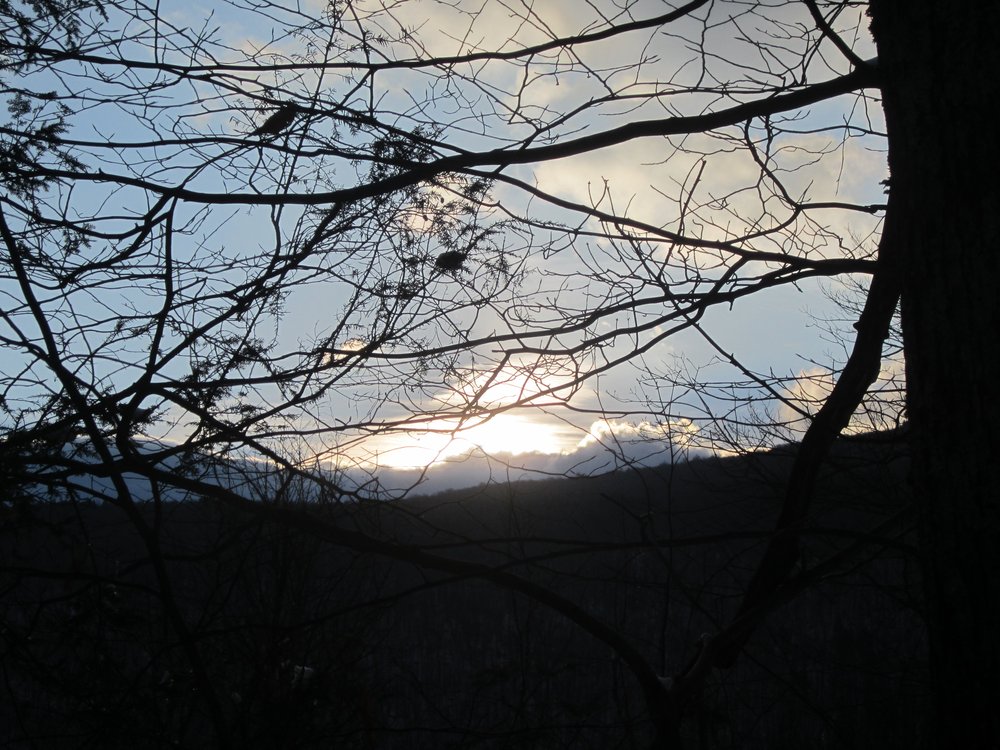
Puzzled, I turned and headed down the trail, which was mercifully broken. Two hundred yards from the trailhead, the Ruffed Grouse flushed from the cover of a downed tree. The flurry of flapping wings delighted me. My first bird of the year.
I try not to place too much pressure on the first bird of the year. But I have come to see them as an omen. A good bird makes me feel lucky, and the hope is that luck will follow me into the New Year. (How we delude ourselves!) I had heard a Carolina Wren singing as I waited for others in the parking lot off of route 28 at 7 in the morning. But the first bird I saw was this Ruffed Grouse. And here’s one cool thing about a Ruffed Grouse: in winter they grow projections off the side of their toes. This creates mini-snowshoes for the bird. We would both be snowshoeing on this long day.
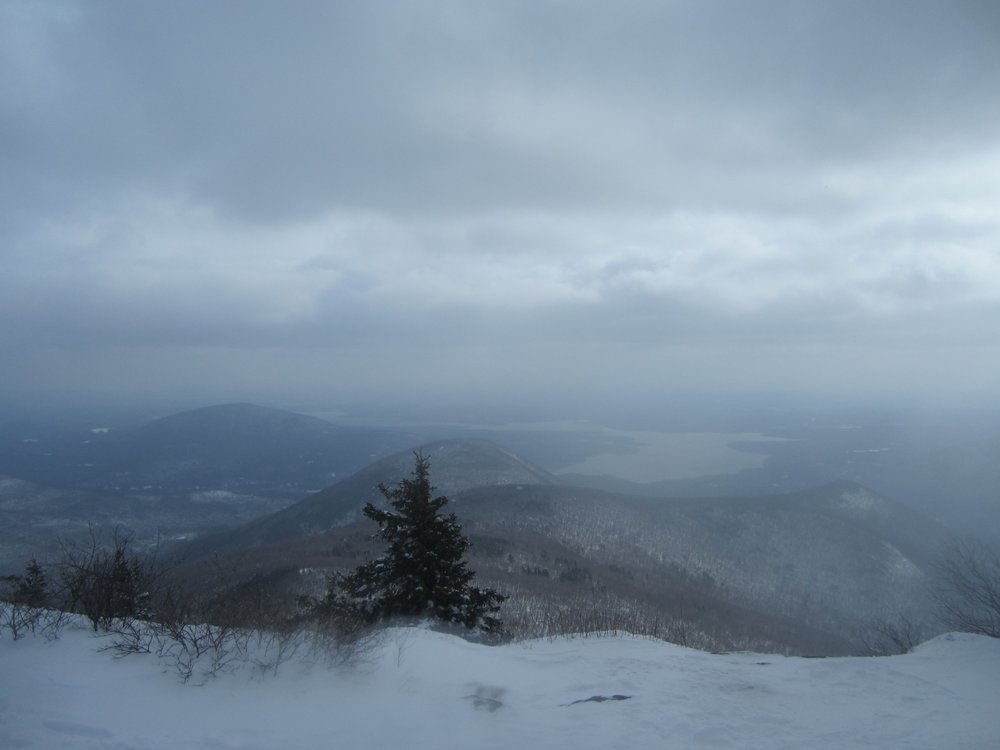
Hiking Alone
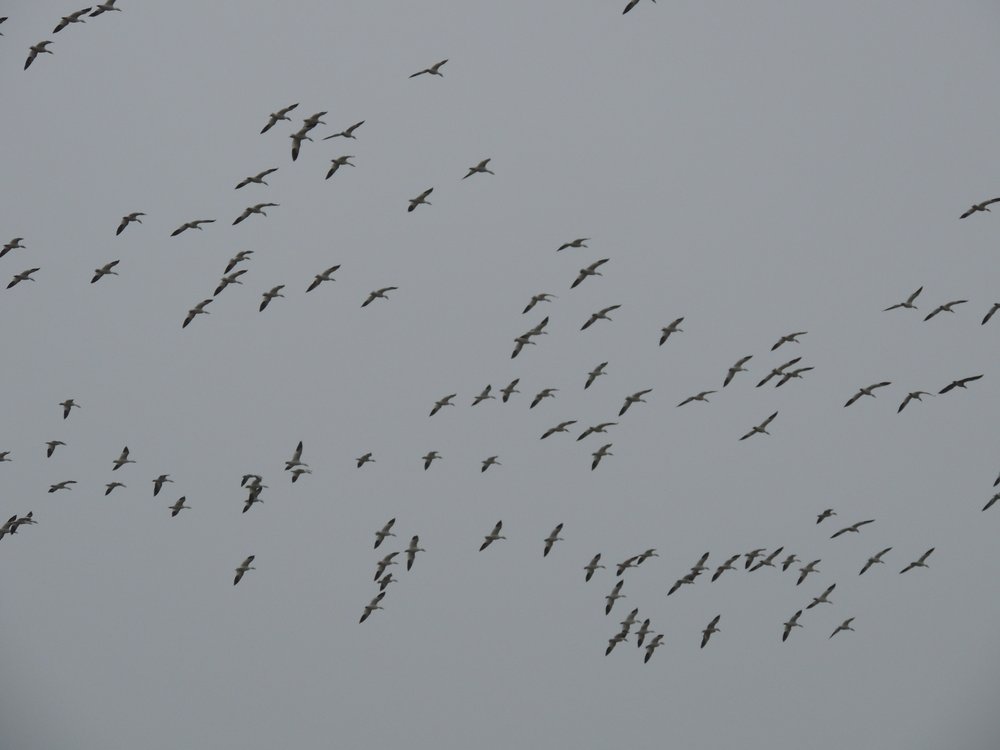
I had wandered my way eastward to this trailhead, stopping at one of my favorite farms to admire flocks of Snow Geese coming in for whatever leftover corn they can find on their route south. Since I didn't know when or if I was going to hike this trail, I haven't let anyone know I'm out here. I know this is not smart--you should always let someone know your hiking plan. But I'm feeling cut loose in many ways, so I'm out here, wanting my inner and outer worlds to align.
It's a strange feeling, this sense of being unaccounted for. It’s not that there is no one to care; it’s that no one is allowed to care. I want to feel alone. This could lead to a sense of loneliness or alternatively, to a slight euphoria, the elation of freedom. It's the later feeling that took hold as I started up the steep trail.

I had wandered my way eastward to this trailhead, stopping at one of my favorite farms to admire flocks of Snow Geese coming in for whatever leftover corn they can find on their route south. Since I didn't know when or if I was going to hike this trail, I had not let anyone know my plan. I know this is not smart--you should always let someone know your hiking plan. But I'm feeling cut loose in many ways, so I was out there, wanting to walk into that sense of alone.
It's a strange feeling, this sense of being unaccounted for. It’s not that there is no one to care; it’s that no one is allowed to care. This could lead to a sense of loneliness or alternatively, to a slight euphoria, the elation of freedom. It's the later feeling that took hold as I started up the steep trail.
I don't mind that the trail is steep, but I do mind that it's covered in leaves; it was hard to tell what might give and what would take my weight. I slipped a lot, reaching for tree limbs to stabilize me. As I climbed, I felt my heart thumping in my chest. I liked how solid it felt, pushing against my ribs.
Three men and two dogs appeared on the trail above me. They were sliding down the trail, hanging onto trees and rocks, sitting down to maneuver over the larger boulders. I pet the collie dog’s long, fine nose and asked her if she wanted to join me. The men laughed as we continued in our opposite directions. As I turn and briefly watch them slide down to the parking area, I thought: Now I am out here alone.
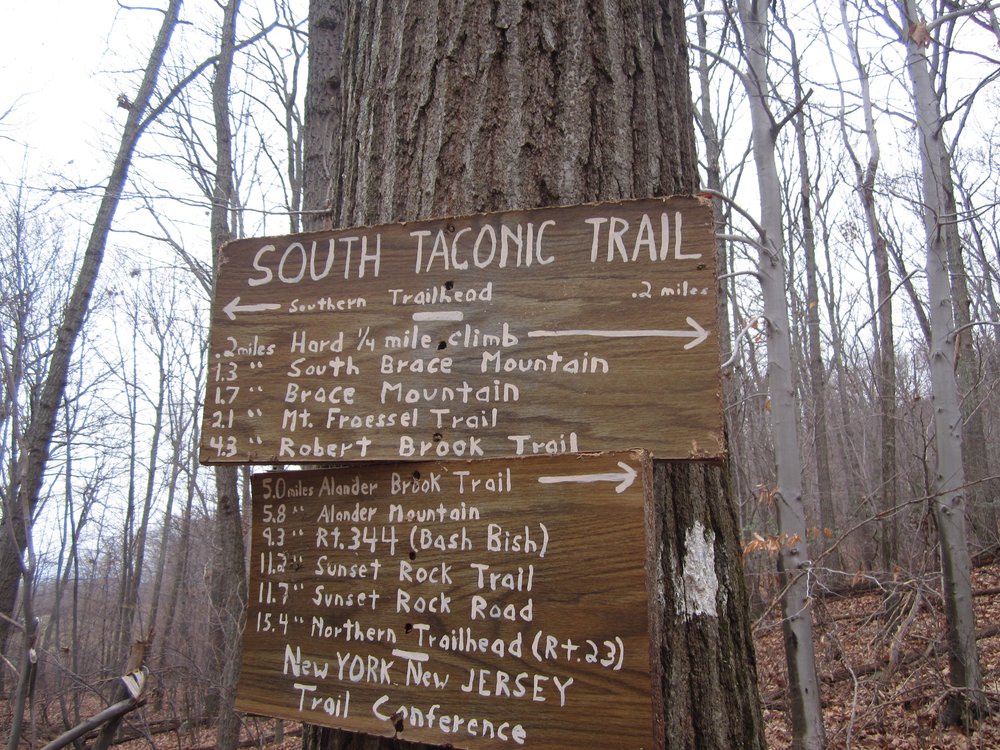
While we climbed in the canyon, we had some friends who--when they were not stoned--knew where we were. It was small but real comfort. But once we were in the park, we were on our own, in this day long before cell phones. Once a week I wrote to my parents to tell them where I was and what I was doing. I lied a lot in those letters. They thought I was sharing an apartment with friends; I was sleeping in a parking lot. I told them I was eating well; we had rice with powdered soup mix most nights. I wondered how long it would take before my parents reacted to the fact they hadn't gotten a letter. And then what would they do? Start searching the state of Colorado? What I realized is that we could disappear and it would be weeks before anyone would sound the alarm, come looking for us. It was a strange thought to have at age eighteen but it was a strong and unnerving one. Perhaps it arose because Munch and I were so lost that summer—in our lives and on the rocks--and had a lot of what we jokingly called epics. But it was also because I had a deep sense no one was paying attention. My father was immersed in writing a novel, my mother absorbed in her translation work. Then, I did want someone to care.
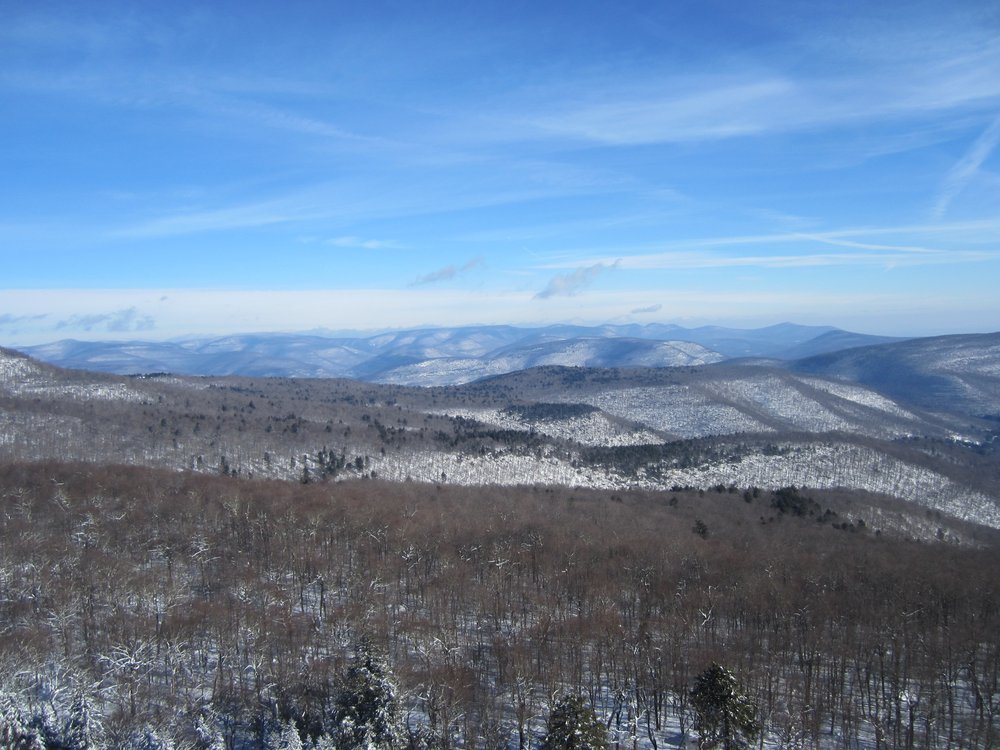
A wind picked up. It gusted over the top of the mountain chilling the sweat on my back. I stopped, drank some water, pulled on a hat. My binoculars dangled at my stomach, but I hardly had use for them. I pished at a squeak from the bushes and a Black Capped Chickadee obligingly appeared to keep me company. They win for most inquisitive, cheerful bird. Down in the valley I could see a long marshy area, which led to a pond, dotted with hundreds of something—ducks, geese—that were too far off to identify.
At the summit of South Brace rests an enormous rock cairn. On clear views there would be views into Connecticut, Massachusetts, New York. Instead, the wind kicked up, gusts that smelled like a storm, like bad weather. I kept on down the trail heading for the summit of Brace and after a hundred yards stopped. I pulled out the map and calculated how far I had to walk to the summit. It seemed ridiculous not to get there, but I didn’t want to get caught out in a storm, adding rain or snow to my slippery descent. I turned around and headed back down the trail.
In Rocky Mountain National Park, Munch and I headed for an area known as Lumpy Ridge. We didn’t have a guidebook, but rather a piece of paper with a few notes on it. “The Book,” “Pear Buttress,” “Sundance.” These were the names of the hunks of granite that soared several hundred feet into the thin air. “Do you think this is the Book?” we would ask each other. But on one day we did a climb named “J-crack,” an unmistakable crack, shaped like a J in the middle of a vast granite wall. No one knew where we were, but for one long day, we knew where we were. And that was a relief.
I was just nearing the descent of the steep section when my ankle buckled under me. I stumbled. The pain shot through my ankle. I sat on a boulder and rested. I drank some water, ate the peanuts I had brought with me. I wiggled my ankle to see if the pain remained.
When I was twelve, I sprained an ankle on the summit of Mount Nittany, which shadows my hometown of State College. College students partying at the summit came to my rescue. They fashioned a stretcher out of tree limbs and denim jackets—this was the early 70s when everyone wore a denim jacket. Four young men hoisted the improvised stretcher and carried me the mile and a half to the car. I felt foolish and they felt heroic.
I knew that no one was going to come along and carry me down this mountain. And I knew I didn’t need that. This was a simple twist, the pain perhaps more imagined than real. But as I sat there I went through what I would do if I had to spend the night in the mountains, how I would set up a bivouac, how I would ration my water. It was when I started to imagine how cold it would get—I could hear the water of the iced-over waterfall—that I stood up and weighted my foot.
My first steps made me wince, but as I continued on, my ankle warmed and the pain dulled. I moved slowly, slithering over rocks, grabbing tree roots to help me down. And this story ends like hundreds before it, with me arriving too soon back at my car, and driving home warm and safe, the pull of exercised muscles overriding the emotions of the day, leaving me happy.
Foraged Thanksgiving
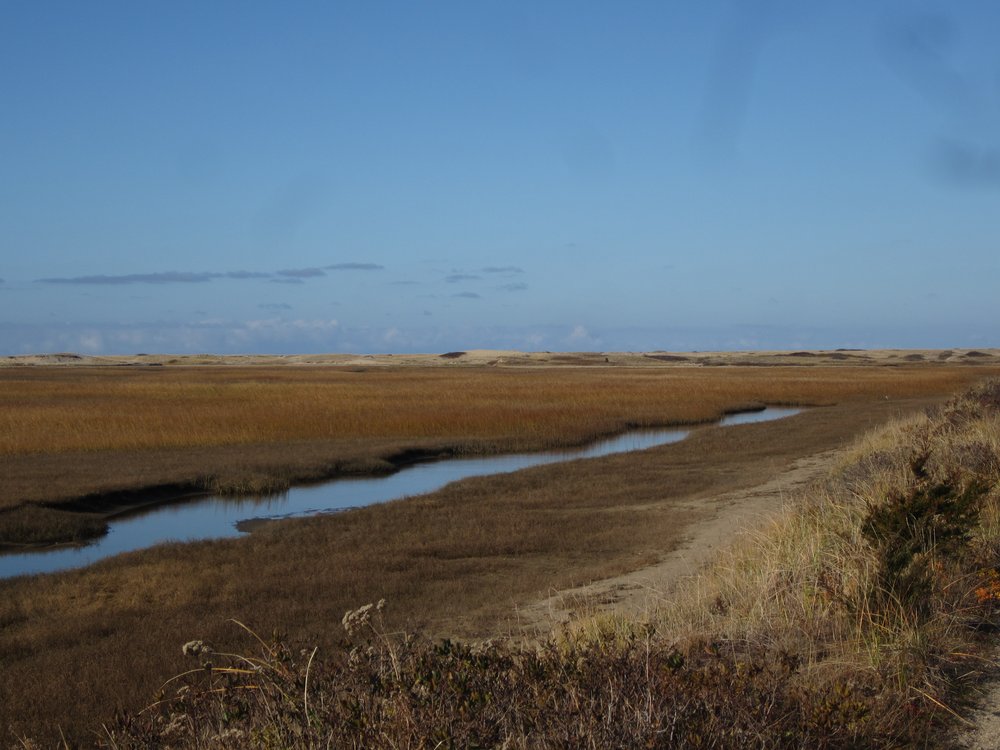
"Thanksgiving dinner?" I asked.
They smiled.
I could feel the elation of the hunt, the story of how they got this bird early on Thanksgiving day. I wanted to ask who was going to pluck the bird, clean it and cook it. There were a lot of soft brown feathers to deal with. For a moment I was jealous of the bird. Pheasant tastes delicious. But I knew I wouldn't be capable of killing the bird. And this day was devoted to eating only food we had gathered ourselves.

"Thanksgiving dinner?" I asked.
They smiled.
I could feel the elation of the hunt, the story of how they got this bird early on Thanksgiving day. I wanted to ask who was going to pluck the bird, clean it and cook it. There were a lot of soft brown feathers to deal with. For a moment I was jealous. Pheasant tastes delicious. But I knew I wouldn't be capable of killing the bird. And this day was devoted to eating only food we had gathered ourselves.
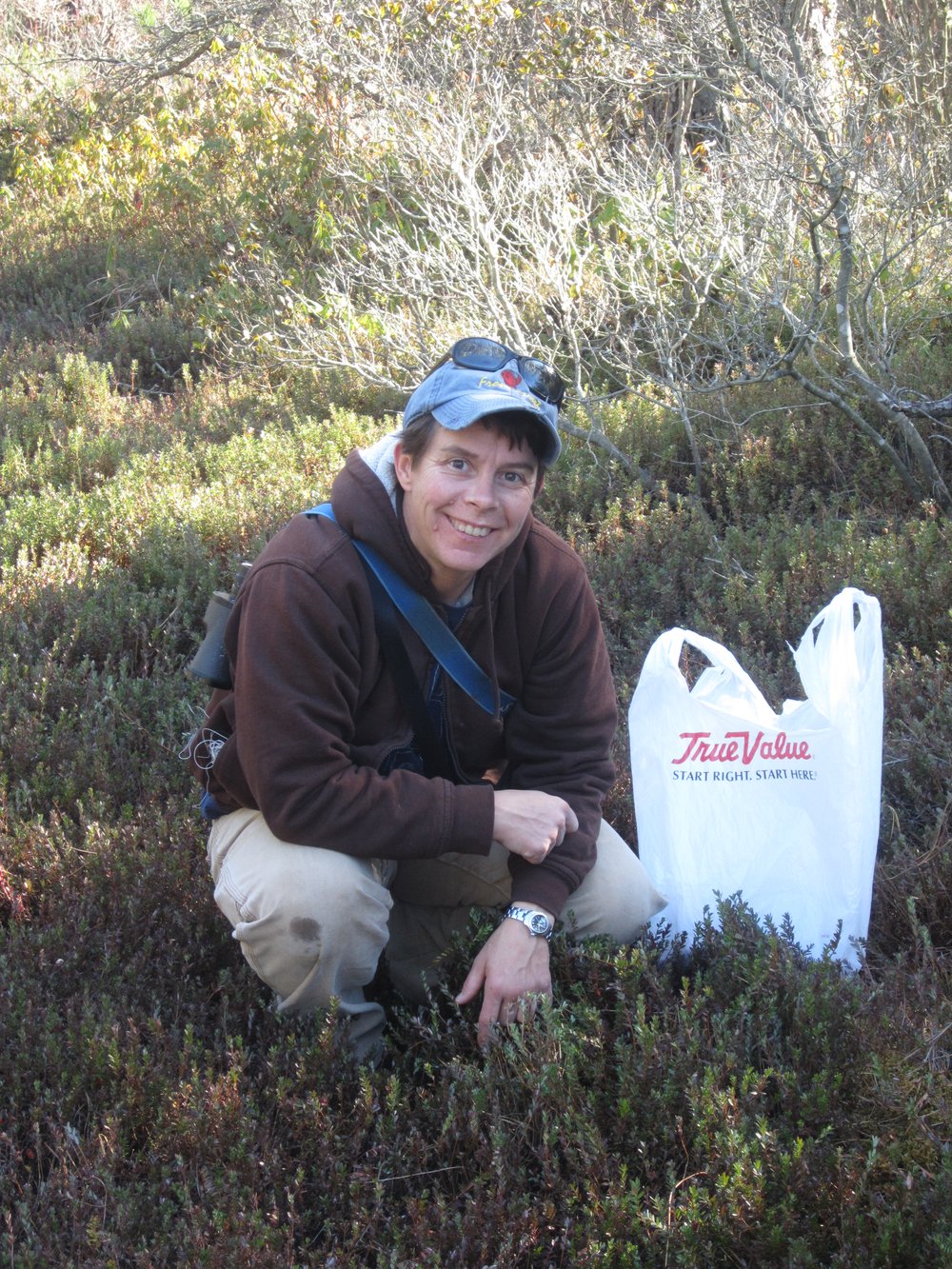
Jody knows these lands well, having lived in Provincetown for almost thirty years. She can lead me to the cranberry bogs, but also to where I might see some Horned Larks and Snow Buntings in the open grassy areas. At one beach there were seals floating nearby, heads bobbing in the cold ocean. We hoped to see whales but did not. Throughout the vast dunes, Jody pointed out fox prints, raccoon, coyote.
This year, the cranberries were sparse. In the past, we had plunked down in a bog and filled our plastic shopping bags. But the first bog we tried was bare. The second patch, nestled around small pitch pines, had a few berries. We worked for them, squatting to see the few bright red berries, taking one or two, then moving on. After an hour we had perhaps two cups. Enough for our meal.

Pulling mussels was easy. We wandered, took a few, then wandered more at low tide. In the distance stood a huddle Black-Backed Gulls and a few fleeting Sandpipers. On the Bay side of the jetty, Common Eider floated near to the rocks, diving for fish. They have beautiful yellow bills and in the clear water we could see them paddling strong to gather their food.
People out for a walk before or after their turkey dinners asked us what we were doing. We boasted about our day of food gathering and a young woman from Manhattan looked incredulous. "Mussels grow here? and you just take and eat them?"
I am no prophet of right eating. I eat organic when I can, eat meat when I want to, but live by no rules. And yet I know we are divorced from what we eat. For one day, I want to know where my food comes from. And I want to know that I could provide that meal. But it's all a game--I wouldn't last long like this and the truth is, cranberries and mussels are not a great pairing.
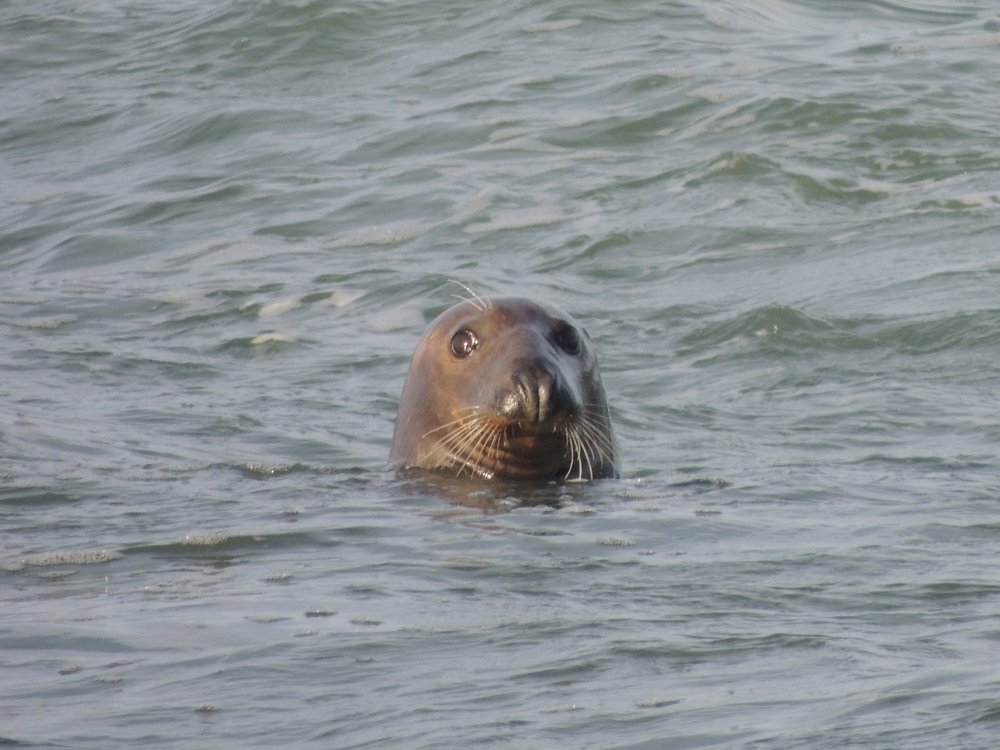
Since those college days we have seen each other at least once a year. I make an annual pilgrimage to the Cape, where my parents spent their honeymoon and where their ashes are scattered in the dunes. I have known all of Jody's jobs, friends, loves—and her pets. On this trip there are two new orange cats George and Fred, and Griffin, the wonder dog who as a puppy joined us on a forage day. We both ponder aloud our single lives. There is no regret; we are both enjoying our freedom, and the fact we are meandering freely together through this beautiful day.
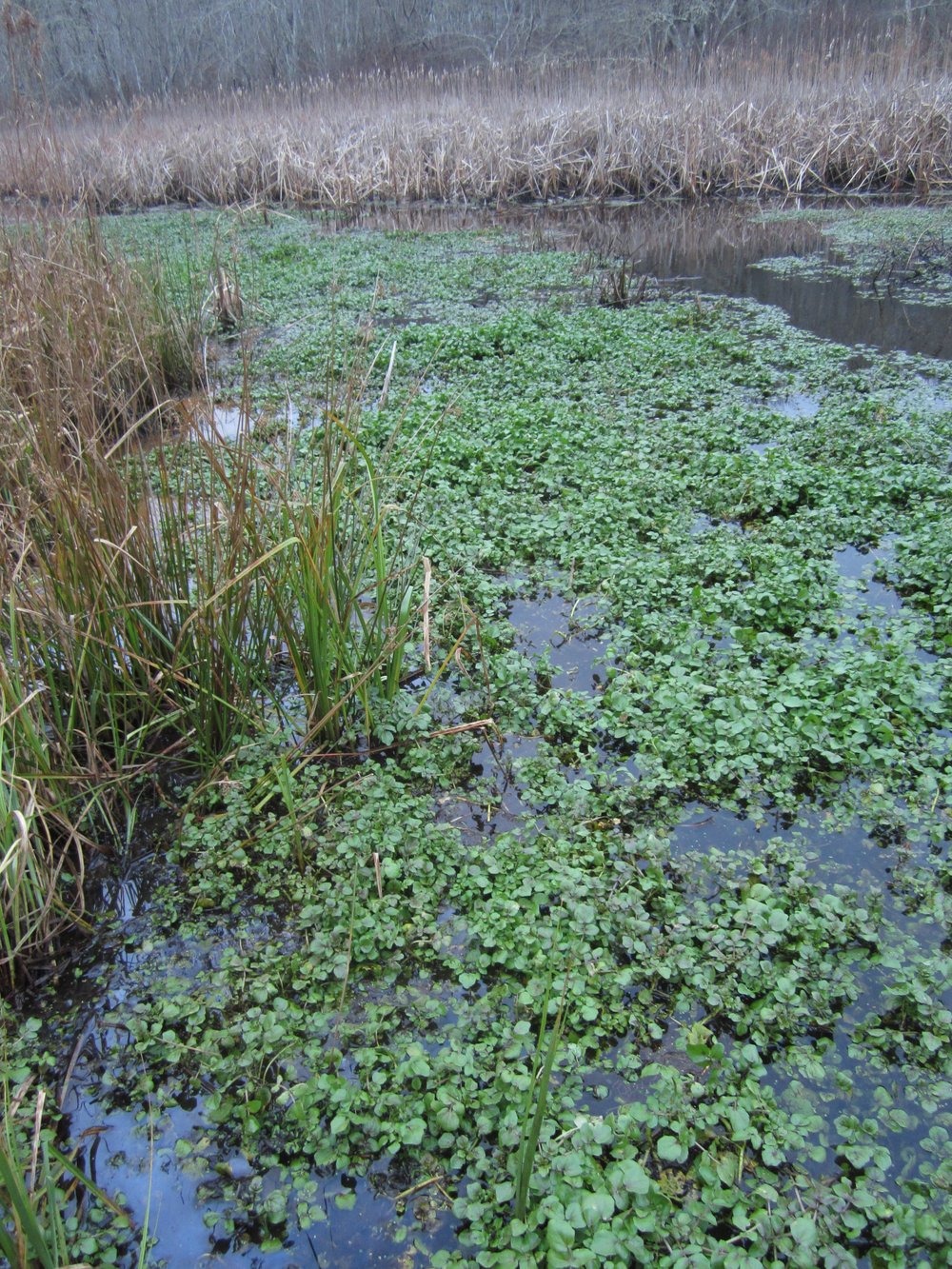
Southern River Kinship
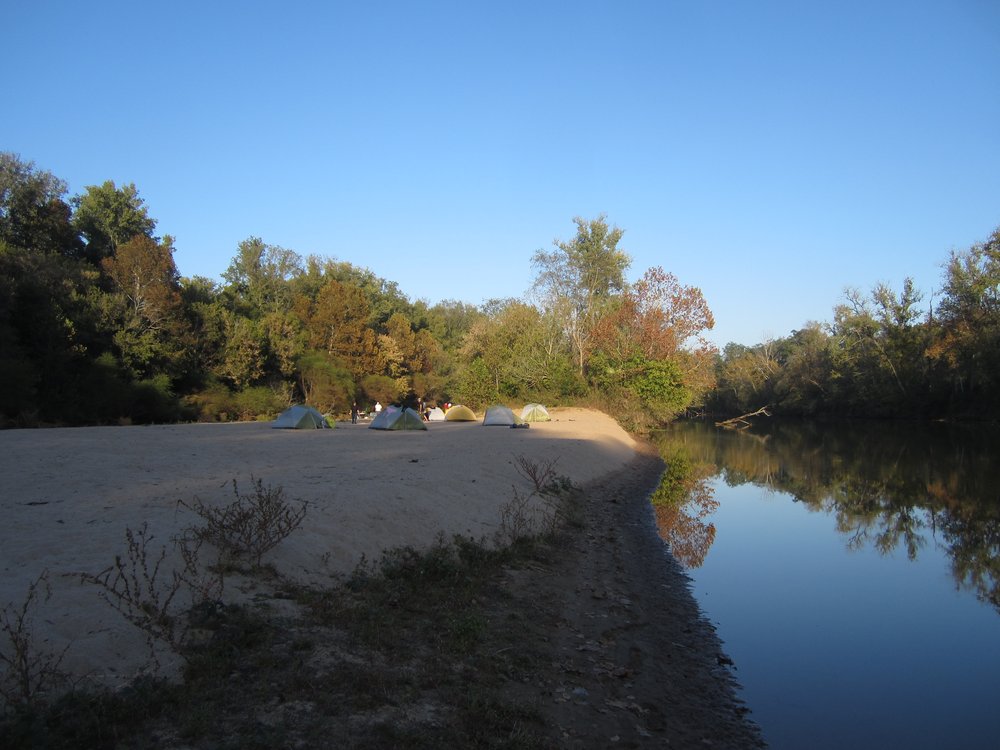
I unzipped my tent and slipped out into the cool of the South Carolina October morning. The sun, if it was trying to shine through, had a challenge in the gray cloud cover. I walked toward the still river hoping to see some sandpipers working the sandy shoreline. Perhaps in the night, while the Barred and Great Horned Owls hooted, some small bird had flown in. But the sandy shoreline wasn’t there anymore. Had I mis-remembered the soft bank of this island?
I walked past a half dozen stilled tents to the kitchen area, where I hoped to find some coffee. Bob, who runs river trips and had orchestrated the details of this float, had the pot set up. All I had to do was turn the knob and light the propane burner. This was cushy camping.
I looked over at the four sit on top kayaks, two regular kayaks, the wooden hand made canoe, and the supply raft. Something was missing.
“Where’s the second raft?” I heard Bob’s voice to my left.
Indeed, it had floated off in the night.

I unzipped my tent and slipped out into the cool of the South Carolina October morning. The sun, if it was trying to shine through, had a challenge in the gray cloud cover. I walked toward the still river hoping to see some sandpipers working the sandy shoreline. Perhaps in the night, while the Barred and Great Horned Owls hooted, some small bird had flown in. But the sandy shoreline wasn’t there anymore. Had I mis-remembered the soft bank of this island?
I walked past a half dozen stilled tents to the kitchen area, where I hoped to find some coffee. Bob, who runs river trips and had orchestrated the details of this float, had the pot set up. All I had to do was turn the knob and light the propane burner. This was cushy camping.
I looked over at the four sit on top kayaks, two regular kayaks, the wooden hand made canoe, and the supply raft. Something was missing.
“Where’s the second raft?” I heard Bob’s voice to my left.
Indeed, it had floated off in the night.
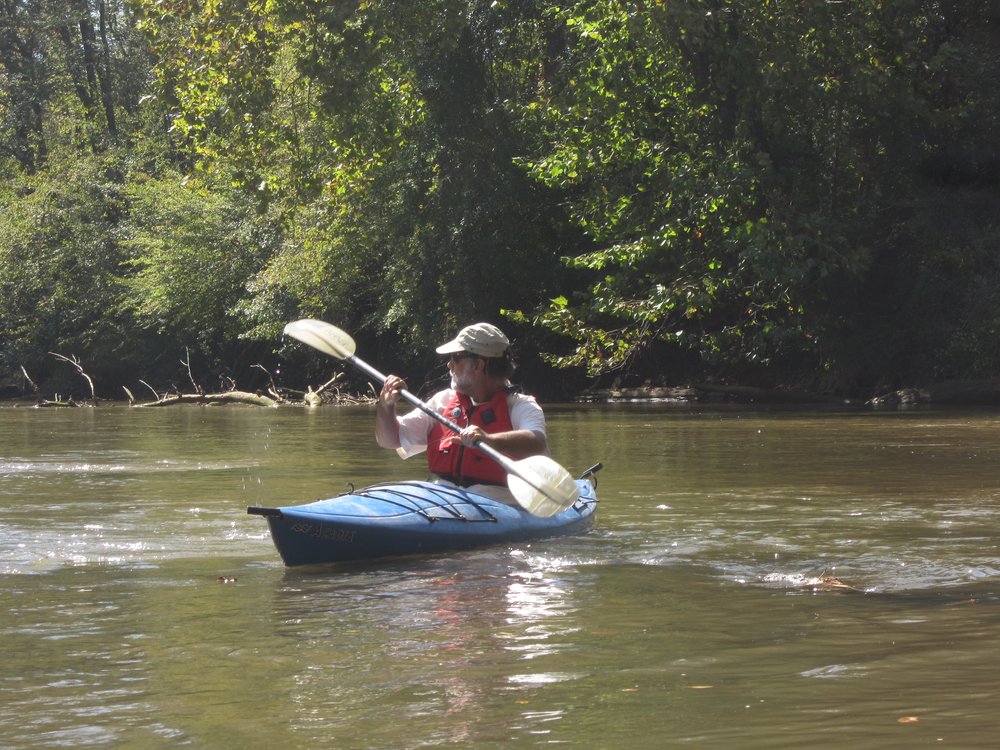
We were now off to experience John’s rivers, first the Pacolet and then the Broad. With us were three Wofford students; Haley, who assists the Environmental studies program; and Kaye Savage and Terry Ferguson, who both teach in the Environmental Studies program. Yes, there were twelve of us on this trip.

On Saturday morning we had gathered in Spartanburg to assemble the most amazing amount of gear. There were enough dry bags to equip an army. But also—we had a stove, a camp table, an enormous cooler, a poop tent, and tents, pads and sleeping bags enough for everyone. We drove south and east through beautiful pine forests to launch on the Pacolet River. I had read about the Pacolet in John’s book, My Paddle to the Sea. In it, he sets his canoe into the Pacolet in his back yard and heads toward the sea. Reading about this journey (I wrote about his and Mike's books earlier) I had been jealous—that he had a river in his back yard and that he could wind through rivers with such lovely names as the Broad and Santee, the Congaree. Though I love my Hudson River, it and its name do not hold the mysteries of a winding river shaded by sweet gum on a red-sand riverbank. Being on the Pacolet my envy returned. It’s an intimate river, narrow and snag-filled, with sycamore trees hugging tight to the water. It was all green and easy paddling, the current in the shallow water scooting us along. Carolina Wrens echoed their song from the river-side bushes, and Mockingbirds, the sound of the south, kept us company with their musical play. I would mosey along, having a conversation with Mike about crows or books that he loves, then loll in the water looking at a Phoebe until Kay and Allison stroked by in the wooden canoe, or the raft with the Wofford students coasted up, their talk and laughter adding to the tonic of the river.
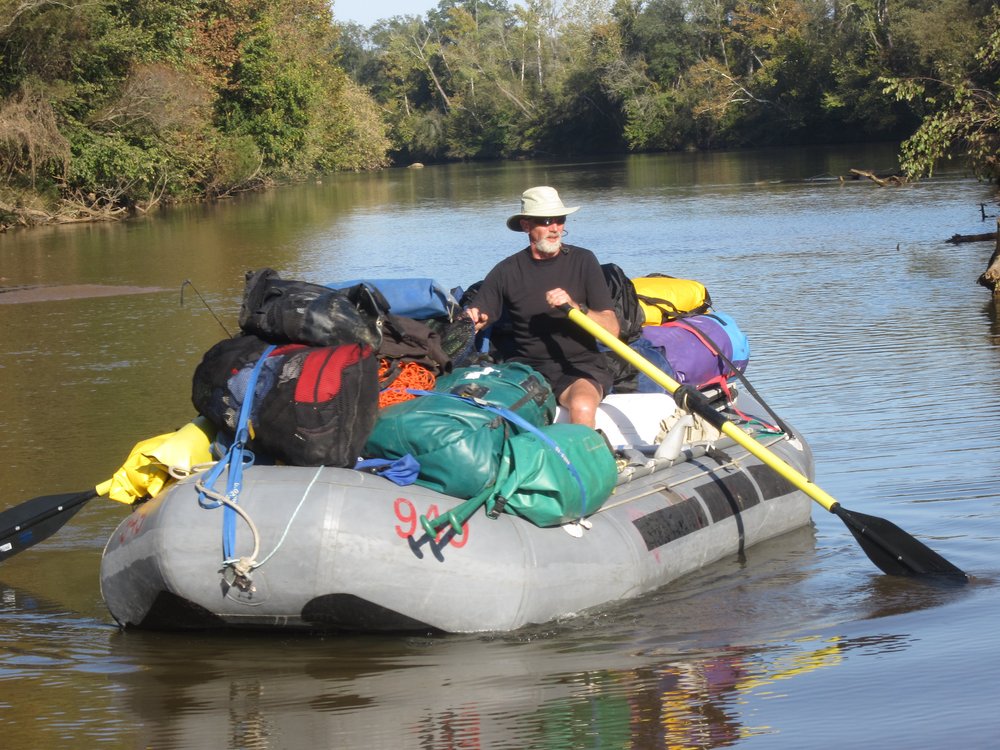
If there is one way to get to think like a river it is to spend time on a river. There, I experienced time differently, the years this river has flowed, and the no-time that it took us to arrive at the Broad River. There, the world opened up, the river less lively then the Pacolet, but more assured. The Wofford students spread onto the rounded sides of the gray raft, legs draped over the sides, and napped as their boat made its way downstream (until, of course, one of them fell out of the boat!). Soon we had pulled up on Goat island. In my reach of the Hudson we also have a Goat Island, with its rocky shoreline and tall trees. This island had a tuft of small trees, but consisted mainly of a wide sandy beach, perfect for our many tents. I pulled my kayak partially out of the water, thinking that this Broad River was not tidal like my Hudson. Nothing would sweep it off in the night.
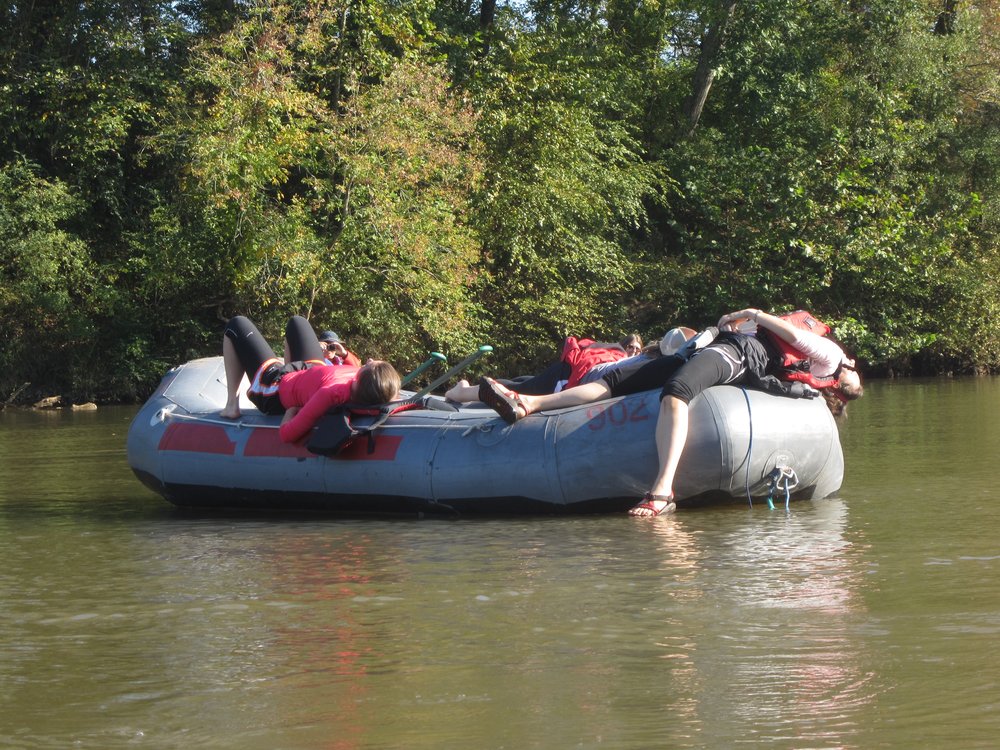
The next morning, the quiet Goat Island transformed as everyone was up and packing tents, stuffing sleeping bags, drinking coffee, marveling that the raft had been swept off in the night (my kayak was just held to shore). A dam upstream must have been released. John, Mike and I left early in our kayaks, and before we left, Allison sang a native song to the spider. The spider would help us find the raft (which we hoped was not hung up at the dam in Lockhart). She sang, then made an offering of coffee to the spiders. And her offering worked: a quarter mile downstream, the fat gray raft had lodged on the bank. John tied it off then we pushed downstream.
